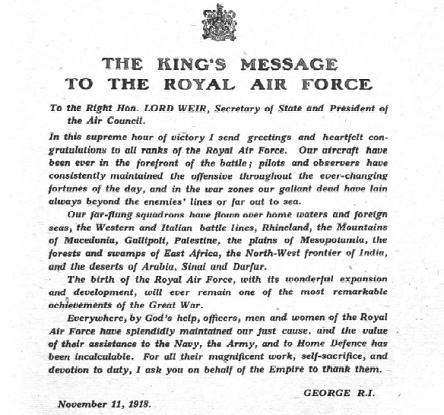Flight, as a journal, had been in publication for only five years when the emerging industry of 'aerial locomotion' it covered weekly was thrust into proving its value as an instrument of warfare.
Ninety years after the signing of the Armistice the entire archive of Flight spanning the Great War is accessible online, revealing how the publication covered the development of aeronautics, and the politics governing it, during the period between 1914 and 1918. Flightglobal has drawn some quotes from the editorial coverage within that archive, and reproduced them below:

"In this supreme hour of victory I send greetings and heartfelt congratulations to all ranks of the Royal Air Force. Our aircraft have been ever in the forefront of the battle pilots and observers have consistently maintained the offensive throughout the ever-changing fortunes of the day, and in the war zones our gallant dead have lain always beyond the enemies' lines or far out to sea."
- Flight's front cover carries the Armistice message from King George V
"Shall we find that the possession of comparatively equal air forces will bring about a position of stalemate, in which both sides find that the game is not worth the candle in view of the enormous casualty bill consequent on the meeting of two hostile air-fleets?
"Or will it be found that machines will be able to come and go almost without let or hindrance owing to the utter uncertainty of finding each other over the vast areas they will cover?"
“We read that ‘it is believed’ the French aviators are continually flying over the advancing Germans, making known to their own commanders the numbers, line of march and apparent intentions of the enemy. But we do not hear a word of what counter-movements are being made by the splendid personnel of the German air service…”
"Every constructor in the country has as much Government work on hand as he can hope to tackle...Whatever the untoward cause may be, the aeronautical industry just now is enjoying a boom which we sincerely trust and believe will establish it on a firm and permanent basis."
- Highlighting the economic lift to the industry created by the conflict, 21 August 1914
"Leaving French territory shortly before 10am, they arrived over their objective at about noon, and, although under a very heavy rifle, machine-gun, and shrapnel fire from the moment they were sighted, they all three dived steeply to within a few hundred feet of the sheds, when they released their bombs - in all eleven."
"The public are advised to familiarise themselves with the appearance of British and German Airships and Aeroplanes, so that they may not be alarmed by British aircraft, and may take shelter if German aircraft appear."
 |
|---|
Flight illustrates its August 1916 report of an extraordinary incident in which 24-year-old French Air Service pilot Marquart de Terline, his machine-gun having failed, rammed an Albatros aircraft to prevent its escape |
"During the year which is now approaching its end the war in the air has reached such a pitch of intensity that it is almost hopeless to attempt to chronicle even the matters of importance. Scarcely a day has passed without its record of raids, accomplished or attempted, by one side or the other.
"A year ago we should have hesitated to pronounce that the aerial war might conceivably be decisive of the whole world struggle, but so great has been the growth in 1917 that not only have we no hesitation in regarding the air as the decisive fighting sphere, but it is possible to say that this is the fixed opinion of every military authority."
- Recognition of the critical importance which aircraft will play in future conflict, 27 December 1917
"Day by day and night after night our air squadrons are making every moment hideous to the enemy. They have searched his bivouacs and concentration areas with bombs and machine gun fire caused holocausts of casualties in his ranks and have done far more than is yet realised in the holding up of his massed advance."
"Since Captain von Richthofen was the pursuer, he cannot well have been hit by his opponent in the air, he appears rather to have fallen a victim to a chance hit from the ground."
- Flight reports that the 'Red Baron', fighter ace Manfred von Richthofen, has been fatally downed after notching up 80 victories, 25 April 1918, and later provides coverage of his funeral
"Much as this criminal war is to be deplored, it will at least leave one great mark upon the world's history, outside the ghastly horrors and ruination which its prosecution has entailed. To its sudden advent must be credited the foundation upon a sold basis of aviation as an industry...we may safely prophesy that the twentieth century will assuredly prove to be the Flying Age."
- On the probable industrial legacy of the conflict, 7 May 1915
"...aged 23, who was killed in a fight with an enemy machine..."
Source: Air Transport Intelligence news




















